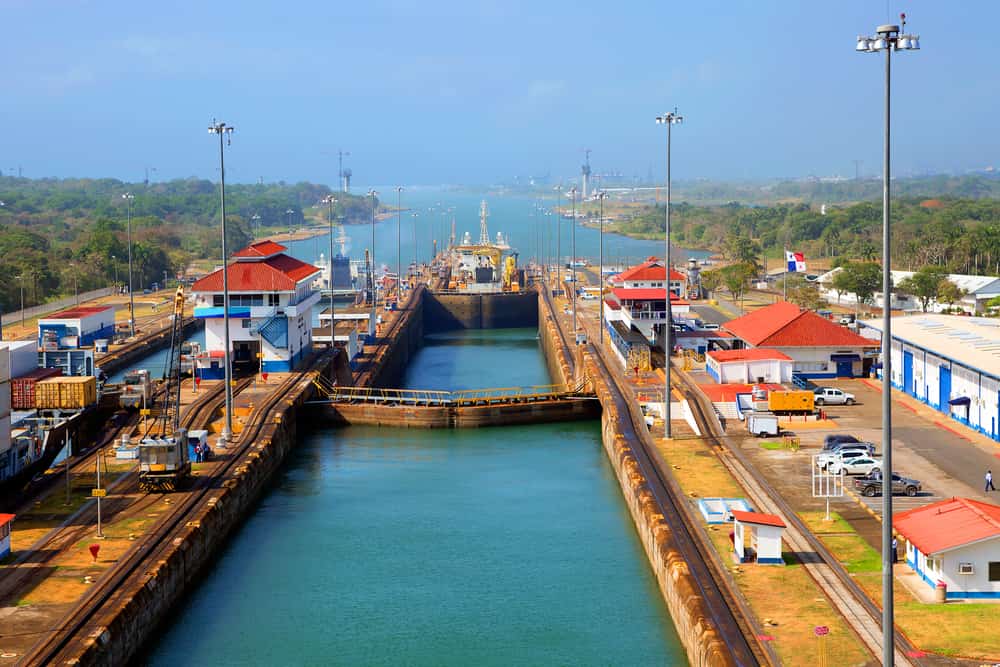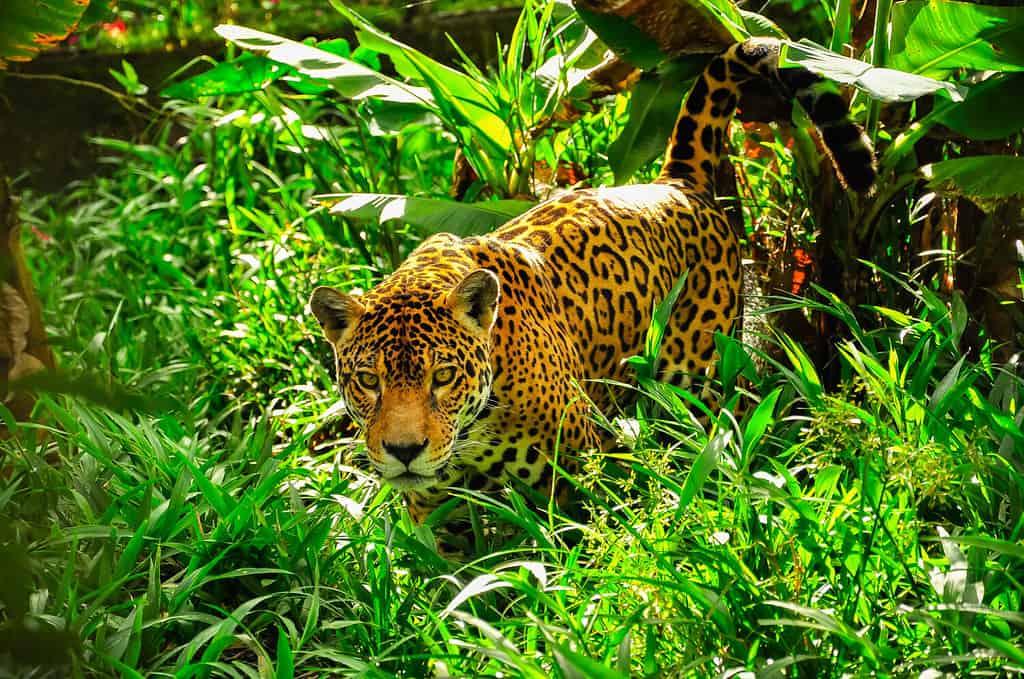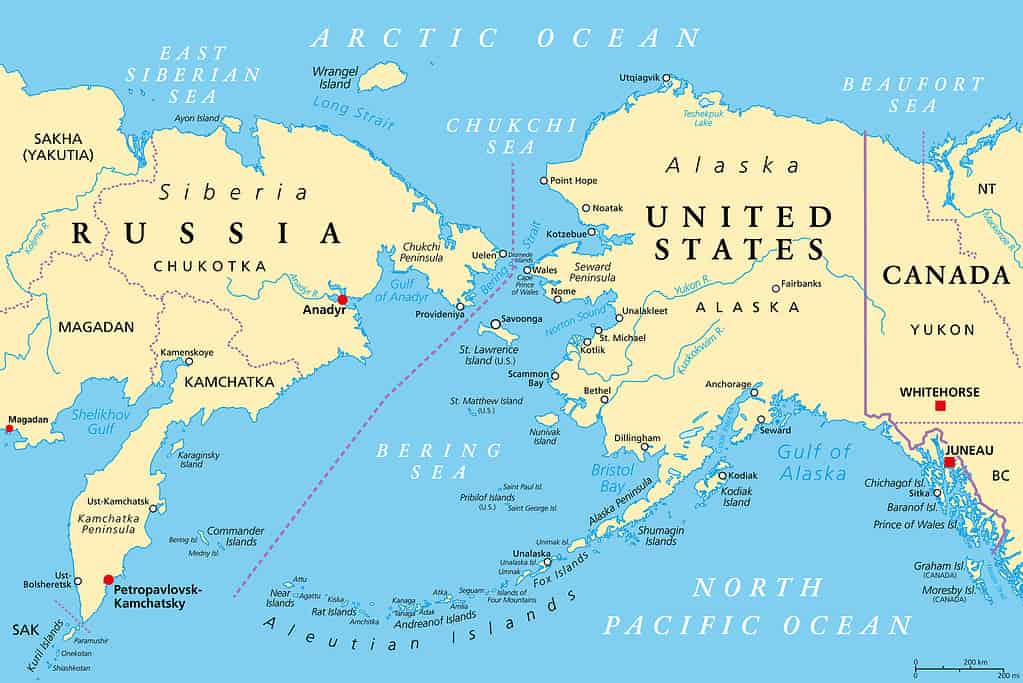The Panama Canal is one of the busiest maritime chokepoints in the world. Since it opened in 1914, over a million ships have worked their way through its locks. As a shortcut to avoid sailing around South America, it has saved shippers a total of at least seven billion miles of expensive and dangerous sea travel. However, despite a major expansion in 2016, ships still back up waiting their turn to cross, and the largest vessels are too big to use it at all.
What if there were a second, larger canal? Nicaragua was a possible canal site before Panama, and the idea is being revisited today. It would bring great advantages for international trade and regional economic development. Let’s discuss the drawbacks and alternatives.
Fast Facts About the Panama Canal

The locks of the Panama Canal lift ships over the mountainous elevation of central Panama.
©Galina Savina/Shutterstock.com
- European explorers conceived the idea of a canal across Panama in the 16th century but did not have the technology to build it.
- The United States bought out a French effort to build the canal and helped Panama get its independence from Colombia to secure more favorable terms for building it.
- Panama permanently sold a strip of land across the country to the U.S. for $10 million. The United States chose to return the Canal Zone to Panama in 1999.
- The project took ten years and cost $375 million. By the time it opened in 1914, over 25,000 workers had lost their lives to accidents and disease.
- 32 ships can use the two lanes of the canal at the same time. Up to 14,000 ships go through it every year, paying fees that can run into the millions of dollars.
- The canal locks function like a “staircase” to lift ships a total of 85 feet above sea level as they cross the isthmus.
- Due to the shape of Panama, ships going from the Pacific to the Caribbean/Atlantic must travel in a north-westerly direction to traverse the Canal.
- Despite a major expansion in 2016, the canal still cannot accommodate the world’s largest container ships or U.S. aircraft carriers.
Plans for a Nicaragua Canal

The proposed Nicaragua Canal would connect Lake Nicaragua to both of the country’s coasts.
©Fab Loaiza/Shutterstock.com
U.S. Plans for a Nicaragua Canal
The United States initially preferred Nicaragua over Panama for a canal. The Nicaragua Canal route would have used the San Juan River to access Lake Nicaragua and a second half of the system would have connected the lake to the Pacific. These plans were abandoned when the U.S. got the opportunity to buy out France’s canal-building project in Panama. There were also concerns that active volcanoes in Nicaragua could damage a future canal.
Chinese Plans for a Nicaragua Canal
In 2013, the Nicaraguan government approved a 50-year concession to the Chinese-based HK Nicaragua Canal Development Investment Group to build a canal. The new route would start further north with a set of locks built at Punta Gorda. Other locks on the Pacific side of Lake Nicaragua would be built at Brito. For China, the project is part of a strategy to increase its influence by investing in infrastructure projects in developing countries.
Current Status of the Nicaragua Canal
Currently, the project is stalled. The Chinese stock market crash of 2015-16 impacted its financing. By 2018 there was still no concrete progress. HKND has closed its offices. The company still has the legal rights to build the canal and related projects in Nicaragua. If funding is secured and the Chinese government considers it a priority, the Nicaragua Canal could still be built in the future.
Environmental Impact of the Nicaragua Canal

The Nicaragua Canal would stop the north-south mixing of species like jaguars.
©Jo Reason/Shutterstock.com
The Nicaragua Canal would have a huge effect on the ecosystem. Lake Nicaragua is the second-largest freshwater lake in Latin America. The wildlife there includes tarpon, freshwater sharks, sawfish, and over 300 species of wetland birds, jaguars, tapirs, and various species of monkeys. Nicaragua’s coasts are prime nesting grounds for endangered sea turtles. These are some of the serious environmental problems with this project:
- The average depth of the lake is 44 feet, so an estimated 176.6 billion cubic feet of sediment would have to be dredged to create a shipping channel through it for large ships. Dredging would stir up pollutants and affect oxygen levels in the water.
- The canal would cut the whole country in half. Land-bound animals would not be able to cross it. Isolated populations would have less genetic diversity and reduced survivability.
- Ships passing through the canal would introduce pollutants and invasive species into the lake and connected rivers. These could include aquatic microbes, plants, and animals that cling to ships’ hulls and anchors or contaminate their ballast water.
Other Alternatives to the Panama Canal

Melting Arctic ice may make the Northwest Passage a practical shipping route.
©PeterHermesFurian/ via Getty Images
If Nicaragua doesn’t build a new canal, what alternatives might help solve the congestion at the Panama Canal?
- Widening the existing Canal: Panama could continue to widen the canal to accommodate more and larger ships.
- Building a sea-level canal: A sea-level canal could be built wider and would not require the slow process of filling locks to raise ships step by step over mountainous land. This would require removing entire mountains in a gigantic V-shape cleft to prevent landslides into the canal. It would be expensive and take a long time. And it would allow Atlantic and Pacific marine species to mix thoroughly with unpredictable results.
- The Northwest Passage: In the coming years, ships may be able to travel between the Atlantic and Pacific by going around Alaska and northern Canada as a result of the melting Arctic ice cap.
- The Southern Passage: The passage around the southern tip of South America takes ships through dangerous and stormy seas. However, the route may be profitable for some cargoes and is safer for today’s modern ships than for those of previous eras.
- The Suez Canal: More intercontinental cargoes might head in the opposite direction, using Egypt’s Suez Canal to ship cargoes between Europe and Asia.
Maybe It’s a Problem that Doesn’t Need Solving
What if the limited capacity at the Panama Canal isn’t a problem that needs to be solved? If it takes a long time to transit the canal, shippers will either build this delay into their delivery schedules or pay big money to make the system work. For example, recently a shipper paid 2.4 million dollars in an auction to skip to the head of the line! Companies that can’t pay those kinds of fees will find alternative routes, use a combination of sea and rail shipping, or relocate production facilities closer to their markets. Some companies might relocate from China to Mexico, for example. In the end, the expense and environmental damage of massive geoengineering projects may not be worth it.
The photo featured at the top of this post is © SevenMaps/Shutterstock.com
Thank you for reading! Have some feedback for us? Contact the AZ Animals editorial team.







